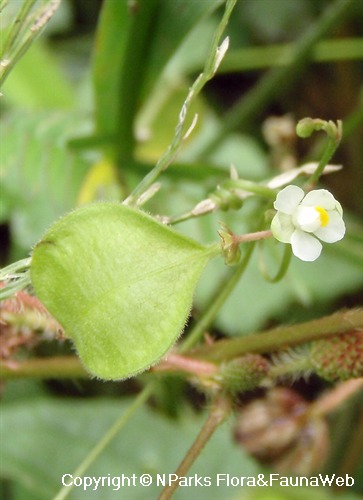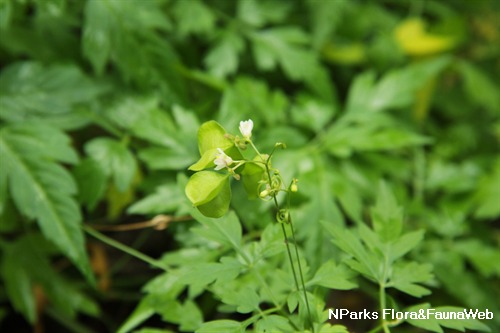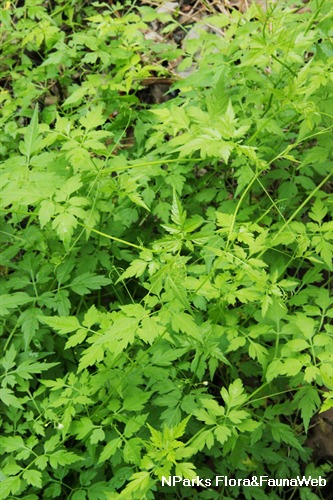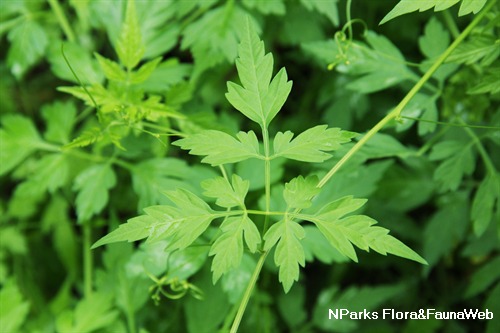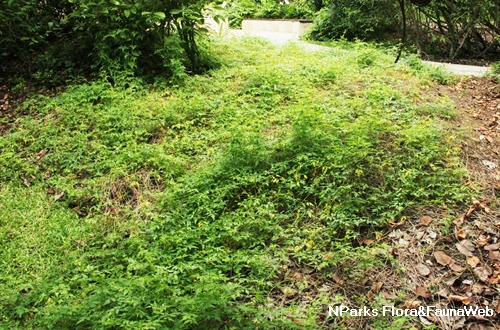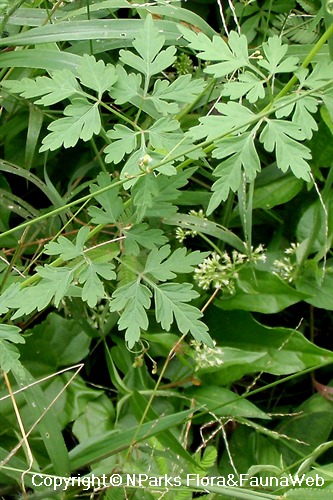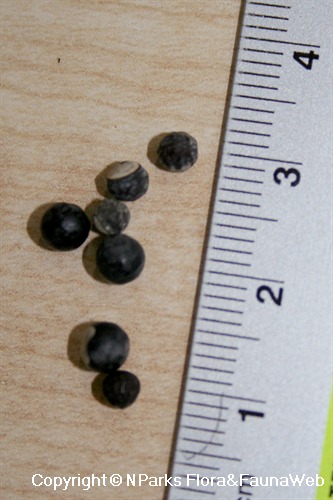.jpg)
Back
Cardiospermum halicacabum L.
| Family Name: | Sapindaceae |
| Synonyms: | Cardiospermum halicacabum var. microcarpum, Cardiospermum microcarpum |
| Common Name: | Balloon Vine, Heart Pea, Heart Seed Vine, Love-in-a-Puff, Puffball, Winter Cherry, Smooth-leaved Heart Seed, 倒地铃, 包袱草 |
Name
Classifications and Characteristics
| Plant Division | Angiosperms (Flowering Seed Plants) (Dicotyledon) |
|---|---|
| Plant Growth Form | Climber, Herbaceous Plant |
| Lifespan (in Singapore) | Perennial |
| Mode of Nutrition | Autotrophic |
| Plant Shape | Irregular |
| Maximum Height | 1 m to 3 m |
Biogeography
| Native Distribution | Central America (Mexico), South America, Tropical Africa, Middle East, Temperate & Tropical Asia, Pacific |
|---|---|
| Native Habitat | Terrestrial (Disturbed Area / Open Ground, Grassland / Savannah/ Scrubland) |
| Preferred Climate Zone | Tropical, Sub-Tropical / Monsoonal, Temperate, Desert / Arid |
Description and Ethnobotany
| Growth Form | Perennial herbaceous vine with slender, downy stems, trailing or climbing with tendrils up to 3m on support. |
|---|---|
| Foliage | Leaves alternate, biternately compound, triangular in outline, papery-thin with serrate margins, lateral leaflets smaller than terminal leaflet. |
| Flowers | Species is monoecious, with male and female flowers found on same plant. Flowers milky-white, small and inconspicuous, produced in axillary racemes with terminal tendrils. |
| Fruit | Showy inflated dehiscent capsules, around 2.5cm across, 3-loculed, papery, pubescent and non-fleshy (unlike most other members of Sapindaceae family), maturing from chartreuse-green to brown, containing 3 seeds each, dispersed by wind and water. Seeds hard, 0.5cm across, black with prominent heart-shaped hilum scar that is green when fresh and white when dry. |
| Habitat | Found in grasslands, shrublands, forest margins, wastelands and cultivated areas in native range. Considered an invasive weed in several parts of the world. Native to Malesian region, grows wild as naturalized exotic in interior and coastal wastelands of Singapore. |
| Associated Fauna | Host plant for caterpillars of tropical American butterflies like Chlorostrymon simaethis simaethis (Silver-banded Hairstreak / St. Christopher Hairstreak), Strymon melinus (Grey Hairstreak) and Hemiargus thomasi (Miami Blue Butterfly). The Hairstreaks lay eggs on young fruits, and caterpillars feed on seeds and pupate inside capsules, while Miami Blue caterpillars feed on flower buds. |
| Cultivation | Fast-growing, takes full sun to partial shade. Prefers well-drained soils, tolerates low soil fertility and dry weather. Pinch off new growth or tie to support to control spread. May be prone to whiteflies and aphids -- treat with insecticidal soap. Propagate by seeds (with viablilty of some 18 months) and stem cuttings. |
| Etymology | Genus epithet 'Cardiospermum' derived from Greek terms of 'kardia' (heart) and 'sperma' (seed), a reference to the heart-shaped seed scars. Species epithet 'halicacabum' derived from Latin name for a type of herb used to treat bladder problems -- either alluding to the inflated fruits' resemblance to a bladder, and/or the plant's purported folkloric effectiveness in treating renal problems. |
| Ethnobotanical Uses | Edible Plant Parts : Edible Leaves, Edible Stems Food (Herb or Spice) (Fruit or Vegetable) Others: Medicinal: Plant is believed to possess cooling and antiseptic properties. Traditionally used to treat fever, colds, renal edema and urinary tract infections. Pounded leaves used as external wash against skin eruptions and eczema, and as poultice for swellings and rheumatism. Leaf juice used to relieve earaches. Food: Leaves and young shoots cooked and eaten as vegetable. Products: Seed oil reportedly effective as insect repellent. Leaves can be coiled into wreaths. Dried fruit capsules can be added to floral arrangements as attractive accent. |
Landscaping Features
| Desirable Plant Features | Ornamental Foliage, Ornamental Fruits, Ornamental Seeds |
|---|---|
| Landscape Uses | Coastal, Suitable for Hanging Baskets, Vertical Greenery / Green Wall, Container Planting |
| Thematic Landscaping | Butterfly Garden, Economic Garden, Naturalistic Garden |
| Usage Hazard - Cons | Invasive / Potentially Invasive |
| Usage Hazard - Cons Remarks | Considered an invasive weed in several parts of world. |
Fauna, Pollination and Dispersal
| Fauna Pollination Dispersal Associated Fauna | Butterfly Host Plant |
|---|---|
| Seed or Spore Dispersal | Abiotic (Water, Explosive Dehiscence) |
Plant Care and Propagation
| Light Preference | Semi-Shade, Full Sun |
|---|---|
| Water Preference | Moderate Water |
| Plant Growth Rate | Fast |
| Rootzone Tolerance | Well-Drained Soils, Saline Soils / Salt Spray, Drought Tolerant |
| Maintenance Requirements | Moderate |
| Propagation Method | Seed, Stem Cutting |
Foliar
| Foliage Retention | Evergreen |
|---|---|
| Mature Foliage Colour(s) | Green |
| Mature Foliage Texture(s) | Velvety / Furry / Tomentose, Papery, Thin |
| Foliar Type | Compound (Trifoliate) |
| Foliar Arrangement Along Stem | Alternate |
| Foliar Venation | Pinnate / Net |
| Foliar Margin | Serrate / Toothed |
Non - Foliar and Storage
| Stem Type & Modification | Woody, Herbaceous |
|---|---|
| Root Type | Underground (Tap Root, Fibrous Root) |
Floral (Angiosperm)
| Flower & Plant Sexuality | Unisexual Flowers , Monoecious |
| Flower Colour(s) | White |
|---|
| Flower Symmetry | Bilateral |
| Inflorescence Type | Panicle |
| Flowering Period | Free-Flowering |
| Flowering Habit | Polycarpic |
Fruit, Seed and Spore
| Mature Fruit Colour(s) | Brown |
|---|---|
| Fruit Classification | Simple Fruit |
| Fruit Type | Dehiscent Dry Fruit , Capsule |
Image Repository
Others
| Master ID | 66 |
|---|---|
| Species ID | 1362 |
| Flora Disclaimer | The information in this website has been compiled from reliable sources, such as reference works on medicinal plants. It is not a substitute for medical advice or treatment and NParks does not purport to provide any medical advice. Readers should always consult his/her physician before using or consuming a plant for medicinal purposes. |

